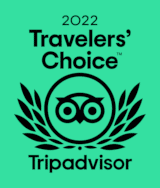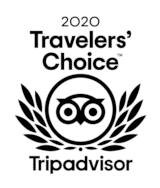Italian Renaissance Painting in the Louvre
The Louvre Italian Renaissance painting tour: A knowledgeable review of the field from its origin in ancient Rome and Greece sculptures to its end with the beginning of the Baroque.
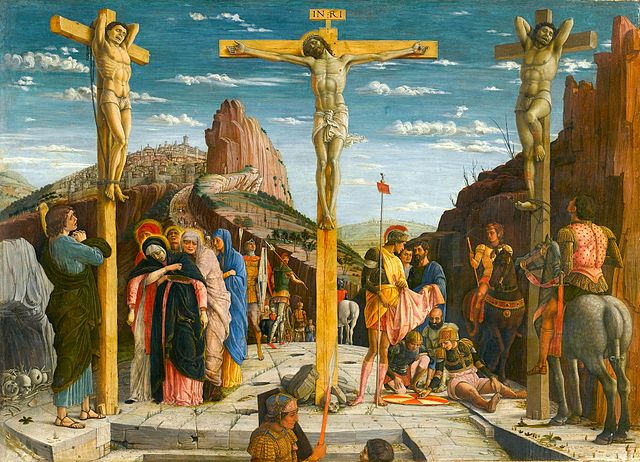
Crucifixion by Andrea Mantegna from Predella San Zeno altarpiece Verona. Credit The Yorck Project – GNU Free Documentation License.
The Louvre Private Evening Tour in a Nutshell
- Guided tour in English
- Genuine private tour = your party only (up to 6 persons)
- Postgraduate (MPhil) certified French national guide
- Not available on Tuesdays
- Two meeting point options: outside or inside the Museum
- Skip-the-line tickets not included to buy online (22 € per adult)
KNOW MORE / BOOK NOW
Your Private Tour Guide in the Louvre
Certified French national guide
BA, Magna Cum Laude, Heritage Developpement & Preservation from Conservatoire des Arts et Métiers
Postgraduate from Paris Dauphine-PSL University
Notions of the Tour: influences
Flanders
Counter-Reformation
Plato
Ancient Rome
Byzance
Notions of the Tour: Debats
Crafts
Colorito
Arts
Paragone
Disegno
Notions of the Tour: Arts & Technics
Canvas
Fresco
Realism
Naturalism
Sfumato
Tempera
Oil Painting
Portraits
Wood Panel
Chiaroscuro
Tenebrism
Mannerism
Locus amoenus
Serpentina
Morbidezza
Warning about croWded Galleries of the Italian Renaissance
The Italian Renaissance paintings are in the Grande Galerie (Great Gallerie) and the Salle des Etats (where is Mona Lisa); these rooms are the most crowded parts of the Louvre Museum (which is the most visited museum in the world). So then, we strongly advise you against booking this tour during high season or pick hours.
To make the most of your Louvre Italian Renaissance Tour, you better book it as an evening one on Friday night, ideally during the low season. You can do it on this page; select the corresponding Friday evening schedule in the booking calendar. Our dedicated page describes the advantages of a private Louvre evening tour in more detail.
Organization & Content of the Tour
The following sections are to give you just an idea of the tour. Its exact content varies each time depending on the circumstances and the public. The works of art which are mentioned are usually shown during the tour but may change.
The tour is organized in height parts.
- Ancient Rome and Grece sculptures
- The early stirring and beginning of the Italien Renaissance
- Plato and the Return of the Men
- Renaissance
- High Renaissance
- Mannerism and Late Renaissance
- Baroque
- Mona Lisa (Des Etats Room)
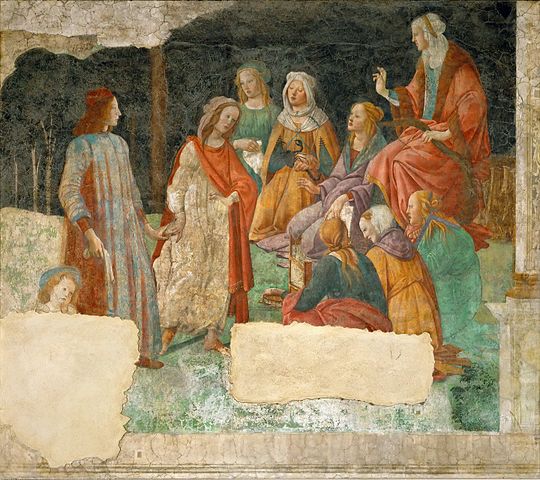
Sandro Botticelli – A Young man being introduced to the Seven Liberal Arts. To have their artistic works recognized at the same level as Plato’s Seven Liberal Arts was a big claim of the Italian Renaissance artists. Credit The Yorck Project – GNU Free Documentation License.
1. Ancient Rome and Grece Sculptures
The rediscovery of the ancient Rome and Grece sculptures was one of the main driving forces of the Italian Renaissance.
The tour starts with Polykleitos, who, in ancient Greece, Classical Period, defined the rules to idealize male body shape in sculpture, and then continues with Praxiteles, who, at the end of the Classical Period, had quite a comparable impact on the female body representation.
Our route will typically also cross two famous Hellenistic period masterpieces: the Venus de Milo and the Nike of Samothrace.
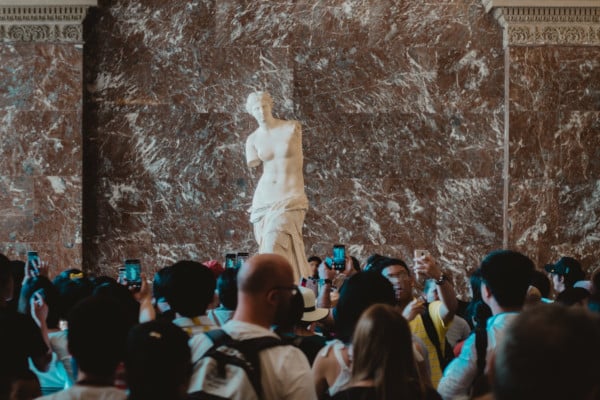
Vénus de Milo. Credit Jean Carlo Emer Unsplash.
2. The Early Stirring and Beginning of the Italien Renaissance
How Italia, step by step, abandoned the static italo-byzantine representations of God on the route toward humanism and naturalism.
Masterpieces examples
- St. Francis of Assisi Receiving the Stigmata by Giotto
- The Maestà by Cimabue
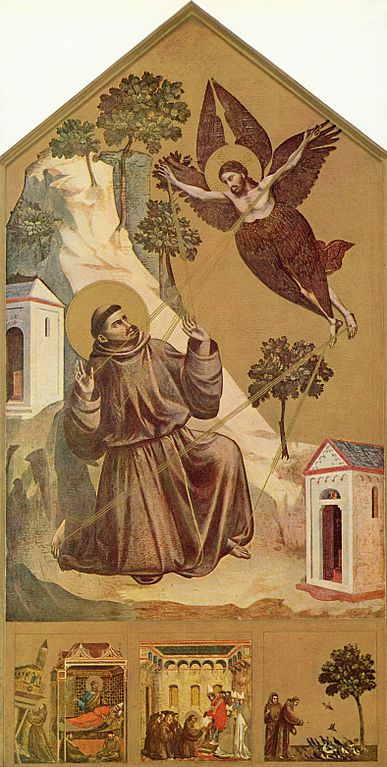
3. Plato and the Return of the Men against Dominican Conservatism
Neoplatonism as a base for the Italian Renaissance
- Madonna and Child with St Fredianus and St Augustine by Fra Filippo Lippi
- The Battle of San Romano by Paolo Uccello
Dominican’s conservatism, the painting at faith’s service
- The Coronation of the Virgin by Fra Angelico
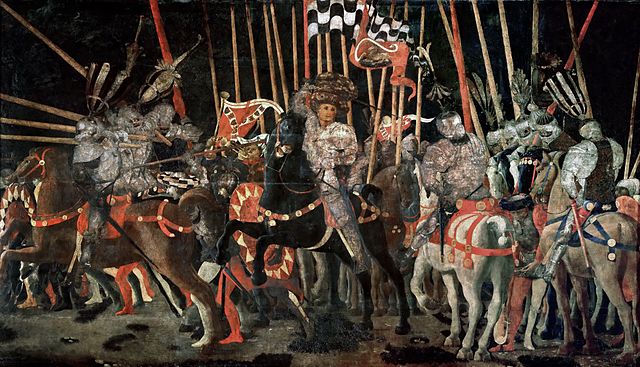
Paolo Uccello, The Battle of San Romano. An amazing work of kinetic art. Credit The Yorck Project – GNU Free Documentation License.
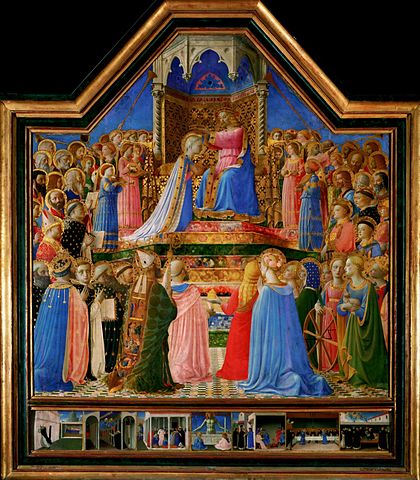
The Coronation of the Virgin by Fra Angelico. Fra Angelico despite of his conservatism is considered one of the first to abandon the gold ground style to develop naturalistic backgrounds. Credit The Yorck Project – GNU Free Documentation License.
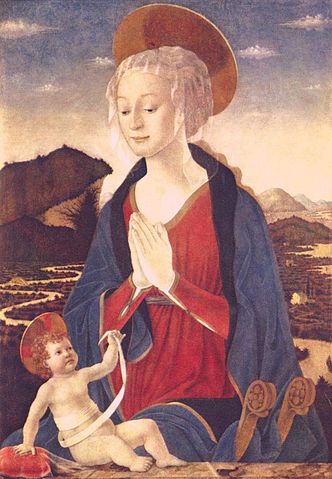
Alesso Baldovinetti Madonna and Child By the master of Ghirlandaio. Credit The Yorck Project – GNU Free Documentation License.
4. Renaissance
The plenitude of Italian art: how the Quattrocento paves the way for the genius of the High Renaissance.
Masterpieces examples
- Madonna and Child with the Young St. John the Baptist by Botticelli
- A Young Man Being Introduced to the Seven Liberal Arts by Botticelli
- St. Sebastian by Mantegna
- An Old Man and his Grandson by Domenico Ghirlandaio
- Portrait of a Man Called Condottiere by Antonello da Messina
- Christ Blessing by Bellini
- Saint Sebastian by Pietro Perugino
- Portrait of Sigismondo Pandolfo Malatesta by Piero de la Francesca
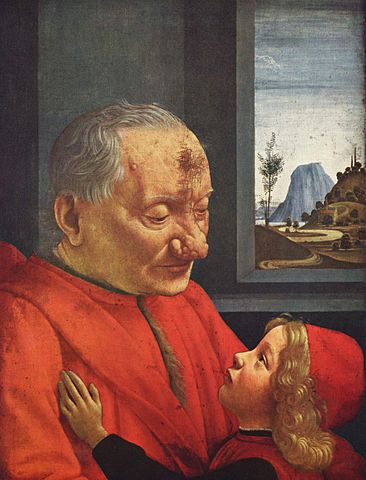
Old man and his grandson by Domenico Ghirlandaio before its 1996 restoration. According to art historian Bernard Berenson, “There is no more human picture in the entire range of Quattrocento painting, whether in or out of Italy.” Credit The Yorck Project – GNU Free Documentation License.
5. High Renaissance
Masterpiece examples
- The Virgin and Child with Saint Anne by Leonardo da Vinci
- Saint Sebastian by Leonardo da Vinci
- La Belle Jardinière by Rafael
- Self-Portrait with a Friend by Rafael
- The Pastoral Concert attributed to Titian a/o Giorgione
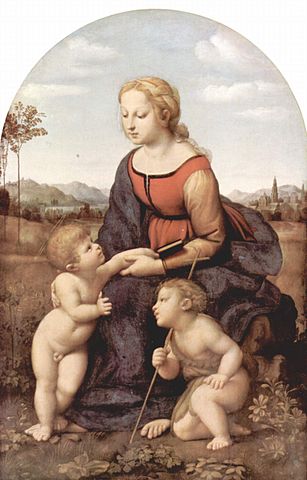
La Belle jardinière oil on panel by Raphael (finished by Ghirlandaio’s soon Ridolfo). Credit The Yorck Project – GNU Free Documentation License.
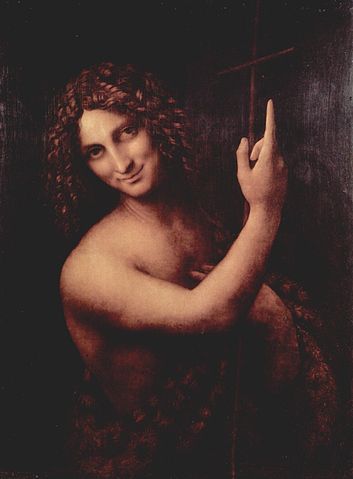
Saint John the Baptist by Leonardo da Vinci. Credit The Yorck Project – GNU Free Documentation License.
6. Mannerism and late Renaissance
Mannerism: how the successor of the high Renaissance genius (Raphael, Miguel Angello, Da Vincci) tried to find their way.
- Paolo Veronese, The Wedding at Cana (first miracle attributed to Jesus in the Gospel of John)
- Daniele da Volterra, David and Goliath (Book of Samuel)
- Giuseppe Arcimboldo, The Four Seasons
- Orazio Samacchini, Mercury Orders Aeneas to Abandon Dido
- Giorgio Vasari, The Annunciation
- Rosso Fiorentino, Pietà
- Parmigianino Mystic Marriage of Saint Catherine
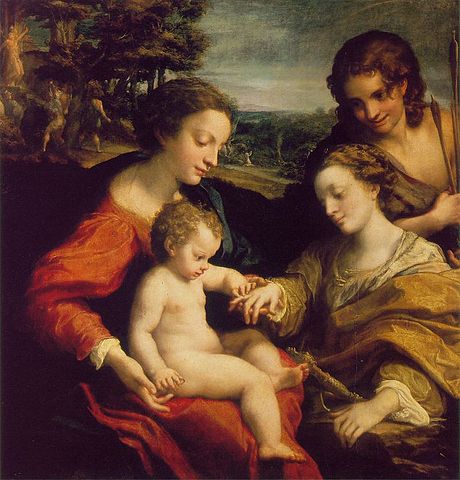
Correggio Mystic Marriage of Saint Catherine with Saint Sebastian, Corregio was first a high Renaissance painter before his mannerism drove him to Proto Baroque works. Credit The Yorck Project – GNU Free Documentation License.
7. Baroque
A rupture with mannerism: The Fortune Teller by Caravagio.
The Catholic counter-reformation in art: Annibale Carracci.
Naturalism & Tenebrism: the death of the Virgen by Caravagio.
The Roman base of French Baroque: Nicolas Poussin.
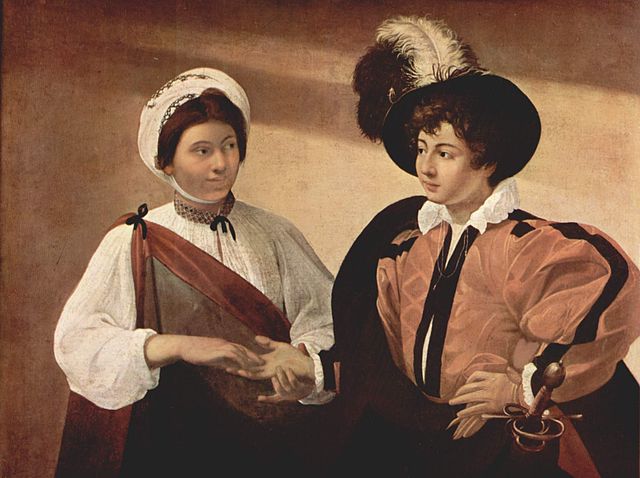
The Fortune Teller by Caravaggio. This rupture work is a milestone in the History of Arts. Credit The Yorck Project – GNU Free Documentation License.
8. Mona Lisa (Des Etats Room)
The Salle des Etats (Des Etats Room) is the most famous and always the most crowded of the Louvre, as it is there that the Mona Lisa is shown.
We don’t comment on the Mona Lisa painting as it is forbidden by the Louvre (too many people). So there is often an extensive unfriendly line to see Mona Lisa. But if you want to look closer, you can line up there just after the tour ends there.
If you follow the Italian Renaissance tour as an evening tour (Friday evening), which is more than recommended, you may have the chance to deal with a more petite or even tiny line.
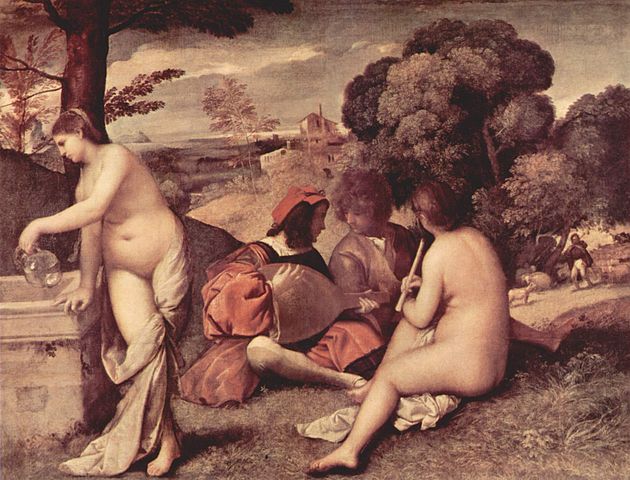
The Pastoral Concert is nowadays attributed to Titian but was previously attributed to Giorgione. This High Renaissance work is located in Salle des Etats, like all the Venetian paintings; the room worst is much more than a long line for a selfie in front of the Mona Lisa. Credit The Yorck Project – GNU Free Documentation License.
Things to know before Booking
Clarification: Skip-the-Line Tickets Are Just Standard Online Ones
Louvre website says "All visitors, including those entitled to free admission (including Paris Museum Pass bearer), must book a time slot. Buy your ticket online on www.ticketlouvre.fr... During off-peak times, there may also be a limited number of time slots for same-day visits available for booking at the museum. However ... to guarantee your entry ... we strongly advise booking your time slot in advance online." Conclusion no magic: During your time slot, you are entitled to enter the online booking security line, so yes, you skip the line... of those who come without a ticket!
Louvre Museum Tickets Fare
Museum tickets are not included in the tour price.
- Online Louvre tickets: 17 € per adult
- Free for all kids under 18 years old
- Free under 26 years old for the European Union residents
Restrictions
- Private tour means a tour for you & your party only, not that the museum is privatized.
- Tour duration & content are purely indicative, they may vary due to contingencies.
- In case of unexpected closed galleries you accept to follow a substitution content.
- Prices do not include transportation, food, drinks or any other extra services.
Attention Points
- Check the Louvre galleries closure schedule before planning your Louvre coming
- Tour on foot in Louvre's huge galleries, so good health & comfortable shoes are mandatory
- Photos are authorized, but without flash. Selfie sticks are not allowed.
- WARNING proof of ID is mandatory as tickets are nominative!
- WARNING print your tickets or at least upload them before coming to the Louvre (last minute problem uploading tickets may spoil the tour)
Meeting Point
Easy one Inside or outside the museum (detail during booking)
Access: Metro Line 1 station Palais-Royal
Book your Louvre Private Tour
confirmation (email)
Louvre Italian Painting Private Tour (2-hours)
Meeting Point INSIDE the MuseumFor 1 to 2 people + 45 € for any extra person
A group of maximum 6 people exclusively yours
Tickets not included
Louvre Italian Painting Private Tour (2-hours)
Meeting Point OUTSIDE the MuseumFor 1 to 2 people + 45 € for any extra person
A group of maximum 6 people exclusively yours
Tickets not included
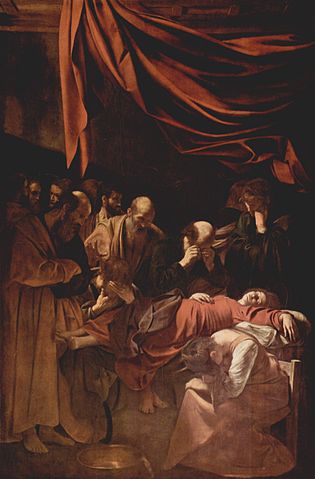
Death of the virgin by Caravaggio. Credit The Yorck Project – GNU Free Documentation License.

